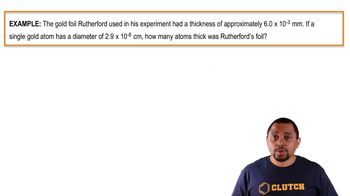Rutherford Gold Foil Experiment definitions Flashcards
 Back
BackRutherford Gold Foil Experiment definitions
1/15
Terms in this set (15)
- Rutherford Gold Foil ExperimentA study that revealed the existence of a dense, positively charged nucleus in atoms, leading to the nuclear model.
- Geiger-Marsden ExperimentAnother name for the Rutherford Gold Foil Experiment, highlighting the contributions of Hans Geiger and Ernest Marsden.
- Alpha ParticlesRadioactive particles consisting of two protons and two neutrons, used to probe atomic structure in the experiment.
- NucleusThe dense, positively charged center of an atom, containing most of its mass, discovered through the experiment.
- ProtonsPositively charged particles located in the nucleus, contributing to the atom's overall positive charge.
- NeutronsNeutral particles found in the nucleus, contributing to the atomic mass but not to the charge.
- ElectronsNegatively charged particles orbiting the nucleus, forming a cloud around it in the nuclear model.
- Plum Pudding ModelAn outdated atomic model proposing electrons embedded in a positive charge 'soup,' disproven by the experiment.
- Nuclear ModelThe atomic model established by Rutherford, featuring a central nucleus surrounded by orbiting electrons.
- Detecting ScreenA device used in the experiment to observe the deflection and passage of alpha particles through gold foil.
- Lead BoxA container used to encase the radioactive element, allowing controlled emission of alpha particles.
- IridiumThe radioactive element typically used in the experiment to emit alpha particles towards the gold foil.
- Atomic NumberThe number of protons in an atom, determining its element, such as helium for alpha particles.
- Mass NumberThe total number of protons and neutrons in an atom, used to describe alpha particles as 4.
- ThomsonThe scientist who proposed the plum pudding model, later disproven by Rutherford's findings.



